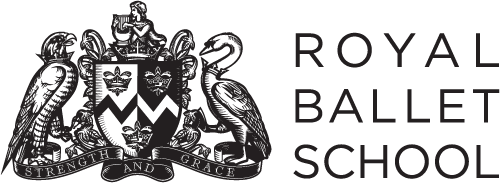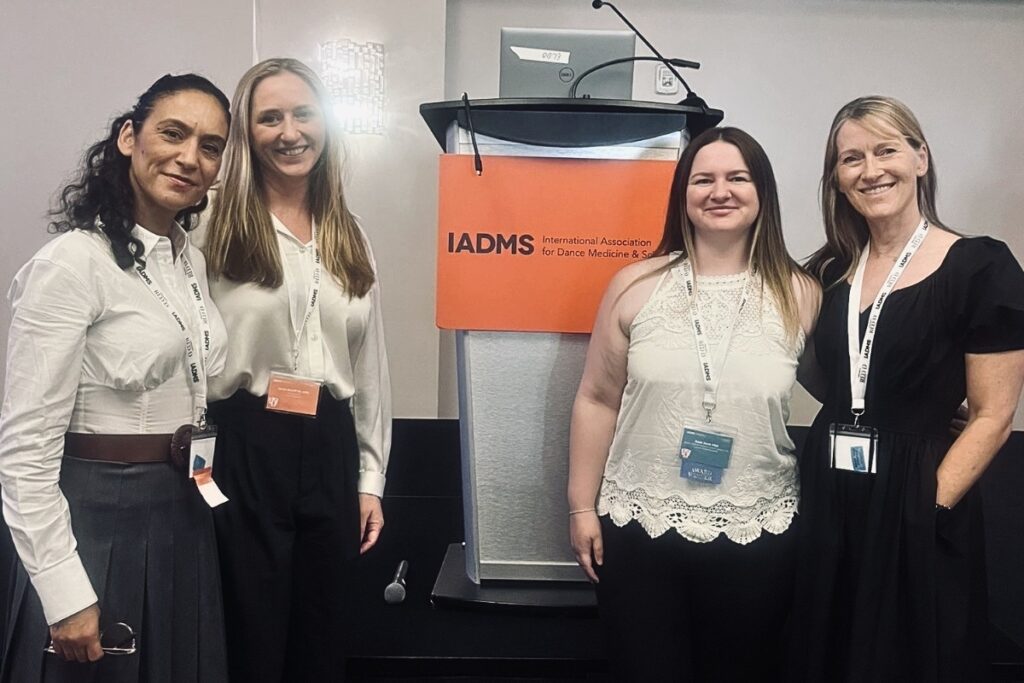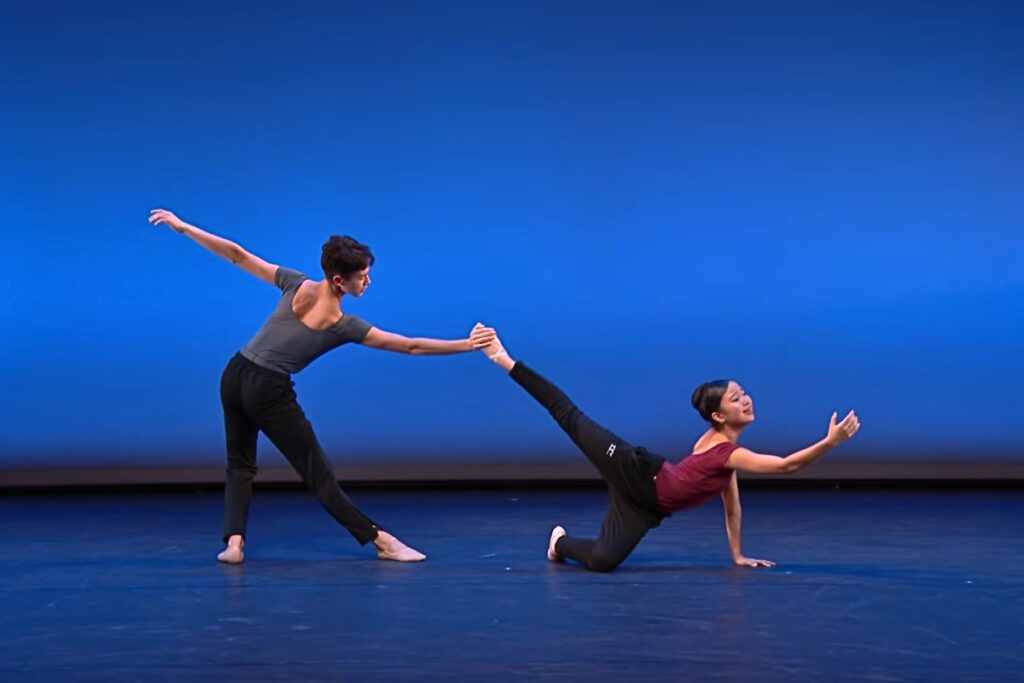Physical Health Lead Erica Gethen Smith Represents the School at the International Association for Dance Medicine & Science (IADMS) conference
We recently marked RED-S (Relative Energy Deficiency in Sport) awareness week at the School from 10-14 November with a series of events. At Upper School, we hosted a seminar with former Head of Healthcare Karen Sheriff about Project RED-D (Relative Energy Deficiency in Dance) along with making smoothies, pancakes and cupcakes. Students also participated in a competition to create a performance meal recipe. We played informational Project RED-D videos at White Lodge, hosted a webinar for parents with Karen and Training and Access Healthcare Lead Emma Porter and shared RED-S themed cupcakes and yoghurt stations with a range of toppings. Our Associate Programme parents and teachers also participated in the events by attending a webinar with Emma.

RED-S has become a growing global topic of conversation in the dance science field, notably at the International Association for Dance Medicine & Science (IADMS) conference. Our Physical Health Lead, Erica Gethen Smith, flew to Las Vegas, USA this September to attend this year’s conference – an annual gathering of global dance healthcare and performance professionals sharing the latest insights into dance preventative care, treatment and recovery method research. Erica is part of the IADMS’s Professional Development and Recognition Committee, a voluntary team that supports the IADMS awards; Erica leads the Dance Educator Award for the conference.
Erica previously attended IADMS conferences in Limerick, Ireland in 2022 and Columbus, Ohio in 2023, where she presented her MSc dance science research with Dr. Manuela Angioi. Each year, researchers are invited to submit their abstracts for an opportunity to present their findings, host a workshop or join a panel discussion. This year, she joined as a delegate, not presenting but learning about the latest research and healthcare practices to bring back to our Performance Team (Artistic & Healthcare teams).
The conference subject areas are really vast, ranging from transgender inclusion in dance spaces to RED-D to testing turnout and pointe readiness. Of the three conferences I have attended, this was the best in terms of breadth of information provided.
After returning to the UK, Erica shared her key takeaways from the conference and new practices she wants to incorporate into the team’s rehab methods and practices at the School.
Project RED-D
Project RED-D is led by our former Head of Healthcare Karen Sheriff, who left the School last year to focus on this new venture. The IADMS conference was the project’s international launch.
Karen gave an amazing presentation, which made a huge impact and really stood out. It generated a lot of discussion about RED-D and how we manage it with dancers. There was also a panel discussion with Dr. Kate Ackerman, a highly renowned medical doctor and specialist in female athlete health; Jenna Caley, RED-D ambassador and former Principal with Birmingham Royal Ballet; Miranda Silveira, RED-D ambassador, freelance dancer and certified nutritionist; Dr. Laura Moretti, nutritionist and Paula Thomson, psychologist.
Hearing from the dancers, with their lived experiences of RED-D, was very emotional and impactful because they shared their own stories of how this condition impacted their dance training, careers and performance. One dancer shared the longer-term consequences of RED-D in her later life. RED-D can affect both female and male dancers in a multitude of ways from increased injury risk, effect on bone strength as well as mental health implications and systemic issues, but it can also have an impact on fertility.
This panel generated a lot of discussion regarding how we support dancers with RED-D and how asking the correct questions and providing holistic treatment can prevent longer term consequences for all dancers.
Positive Balance: a psychoeducational programme for the physical & psychological wellbeing of pre-professional dancers with Queen Mary University of London & English National Ballet School
Dr. Rosie Davis conducted a research project at the School a few years ago called Positive Balance. It was a psycho-educational study assessing whether implementing positive mental health interventions with students helps their wellbeing. Rosie was selected from over 100 international submissions and was one of only three recipients of the Linda Hamilton Symposium Award for this project, the top award at IADMS. Her work highlights the impact of interdisciplinary research in dance science, psychology and adolescent wellbeing.
I remember when the research was done with our Year 11 White Lodge students in 2023. They would attend sessions in the salon together on Monday afternoons, exploring how they felt and putting those feelings into a positive body map. Then, they would try to use the positive reflections of what they learned in those sessions to manage issues that they faced from boarding, dancing or academics. It was a great collaboration between the School and Queen Mary University of London with positive feedback from the students.

Left: Dr. Manuela Angioi with Dr. Rosie Davis after winning the Linda Hamilton Symposium Award; right: Former Head of Healthcare Karen Sheriff presenting Project RED-D
Workload management research
Theano Vikatou from University of East London is conducting interesting research with English National Ballet company on workload management – looking at the impact of physical and psychological workload and its’ effect on professional dancers. This research is conducted within a company setting, but it is also a high priority and focus for us within the School and which we are already addressing and monitoring with our periodised loading, training and programming. This research gave insight into how they measured the impact of workload along with dancers’ perceptions of how this was measured.
Return to Dance programmes
There were a number of fantastic workshops this year, particularly one from Houston Ballet’s Healthcare Team on their return to dance programmes, where they discussed their return to jumps programme and how they get dancers back into the studio and on stage. Their return to jumps programme is very similar to ours, but there were some slight differences that we may introduce to support our dancers further which allows autonomy surrounding rehab choices and potentially dancer motivation to improve engagement in their programmes.
Practical workshops
A number of practical workshops focussed on training hip internal rotation. Since ballet dancers predominantly work in external rotation for turn out, there is great benefit from ensuring balanced muscular control through training of the internal rotators and adductors. In these workshops, there was a generous sharing of techniques and advice on exercise cueing, especially focussed on adolescent dance training, which has proved valuable back in the gym at both White Lodge and Upper School, with students benefiting from these rehab practices.
Another presentation, Dissecting an Arabesque, looked at breaking down the movement of an arabesque into component parts and then working on strategies to improve it. From a physiotherapy and Pilates point of view, these are exercises and methods we can use to help a dancer find an arabesque that works for the individual whilst maximising their physiology.
Strategies and exercises specifically for the hypermobile dancer population focussed on closed chain exercises for stability and increasing proprioception and awareness. There were some novel ideas that I haven’t tried before using compound functional movement patterns which can be used in a studio setting. Student feedback of these exercises introduced at White Lodge has been positive and outcomes related to improvement in pain, especially relating to proximal stability and pelvic control have been noted already following rehab sessions
Finally, there was an excellent workshop on breath control by Thomas Hague & Emeric Rabot on the benefits of incorporating breathing capacity control and other somatic practices in our dancers’ training at an early stage. Sarah Daultry, Teacher Training Manager, has conducted this breath work with students beforeand we plan to revisit this with her and the team again, also incorporating work from a mental health perspective with our Mental Health Lead, Naomi Rogers.
Overall, this was an inspiring four-day conference which the School supported, and it is already benefiting our student population and Performance Team. The next IADMS conference is in Melbourne in September 2026.






